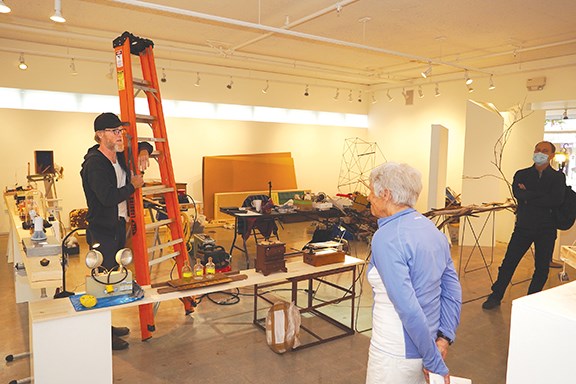We might never know quite what to make of the new exhibition at Gibsons Public Art Gallery (GPAG), but we will know, before the show ends Oct. 4, what artist Matthew Talbot-Kelly makes of it. To call his concept unusual is an understatement. It is to the traditional art exhibit what free-form jazz is to classical music.
The exhibition’s title is a tip as to what he has in mind: “Doctor Kali Gehry’s Cabinet of (in)Curiosities & Ecstatic Nonsense – a Dream Theatre Display Spectacle of Chimera, Folly and Tears.”
Prototype museum
In past centuries, a “cabinet of curiosities” was a prototype museum, each containing a gamut of gadgets and paraphernalia, according to Talbot-Kelly, who trained as an architect and is a self-taught filmmaker and master of quaint assemblages made from found objects.
He has started this project with a small batch of construction materials and a large assortment of cast-off items. On the show’s opening day, Sept. 10, the main room of GPAG looked like a simultaneous construction and demolition site. Building material and a lot of what appeared to be junk was piled everywhere. By Sept. 13, the main room was still scattered with supplies, while on the periphery around the rest of the gallery the artist had mounted displays of re-combined contraptions that were mini-installations in themselves. Where did it all this stuff come from?
“It’s mostly local, from the beach and the road,” Talbot-Kelly said in an interview. Some articles, like a wooden tripod that he has put to counterintuitive artistic use, was bought from a thrift store. “It’s not all garbage,” he said. “Obviously, there’s an aesthetic there. But the stuff has all been discarded,” and as he noted in his artist’s statement, are “evidences of our disposable contemporary lifestyle.”
By repurposing it as art, “I’m making it, I think, valuable, putting it up on a pedestal and saying, ‘I’m honouring this junk,’” Talbot-Kelly said. “It’s an absurd proposition, but at the same time it also makes us ask some questions about what is valuable and what is important.”
Many of the creations are accompanied by a card imprinted with quick-response (QR) code, which can be scanned with a tablet computer or smartphone. “The QR code will take you to my database where you can read the stories about the objects,” he added.
So, the building materials, along with hundreds of discarded odds and ends, will become what? “A cabin,” Talbot-Kelly said, which he said is a larger form of the traditional cabinet. “These pieces will all be incorporated and/or moved around and/or manipulated to be in relation to this cabin. So, the cabin will become the ultimate, perceptual device that I’m creating. It’ll be up for three days.”
Talbot-Kelly intends to take the cabin apart and rebuild it anew for the Sechelt Arts Festival next month, and then take it on the road. “The plan is to move it across Canada and each time I reconfigure it based on local junk, local found objects and I’ll keep on moving and rebuilding it.”
Art gallery operators find that often, a new exhibition will attract visitors just once soon after it opens. This project is poised to bring onlookers back at least a couple of times, right to the end.
You can learn more about the artist, his broad range of his work and view one of his short films, Blind Man’s Eye, at matthewtalbotkelly.com.



